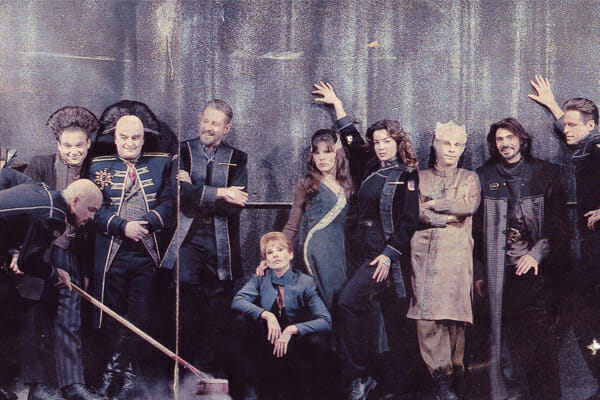By Luke Lyon-Wall · April 17, 2017

November 1998 saw the season 5 finale of BABYLON 5 and with it, the close of a 5 year storytelling masterpiece; the first ‘novel’ for television. Qualitatively better shows have come since, but in terms of longform storytelling nothing in even BREAKING BAD, THE SOPRANOS or THE WIRE has come close to its density and richness. The writer can learn much from J Michael Straczynski’s use of foreshadowing, payoffs and detailed plotting.
The Story Toolkit is a weekly podcast for writers discussing the principles of storytelling, using the best and worst examples of Film, TV and Gaming. Our episode focussing on BABYLON 5 details 5 principles Straczynski used that are invaluable to the writer. Here, we outline a few examples of what elevated the show to a level no one has since achieved, at a time when a 5 season arc was unheard of. A more detailed analysis can be found in our podcast.

1. Set Trap Doors
Straczynski knew that over the course of a 5 year show, for one reason or another, cast members may leave. As a result he set up an exit strategy for each plot line; to whit, a Trap Door.
In the pilot episode of the show, we are introduced to a character called Laurel Takashima, the First Officer of Babylon 5. Unbeknown to her, she was a sleeper agent for the Psi Corps, a nefarious and Orwellian agency of telepaths. This hidden personality named Control was due to play a major part in the Earth Civil war plotline that climaxes in Season 2. However, after the pilot episode the actor along with 2 others left the show, leaving Straczynski with a major problem; what to do with Control.
Straczynski’s solution was ingenious. He planted the sleeper agent personality of Control inside Talia Winters, a Psi Corps agent that replaced one of the suddenly missing characters. As a mole, Talia was able to worm her way into the inner circle of the show, which Straczynski was then able to pay off in an arguably more satisfying way than planned.
Straczynski had a Trap Door for every major character in the show. As a writer, plotting out contingencies such as this can help you adapt to logistical changes outside your control such as actors leaving.
2. Foreshadow
You have opportunities with longform storytelling to accomplish levels of Foreshadowing that no other form allows you to do. In a feature length film, this can come over the course of 2 hours. In the case of the infamous “I am your father” climax to THE EMPIRE STRIKES BACK, this pay off is set up over the course of 4 hours of storytelling. With longform, however, you can have a pay off that goes back 4 years.
Babylon 5 has some great examples of longform Foreshadowing that last between a few episodes, or 5 seasons. In the first season, the Chief of Security Michael Garibaldi is continuously told by characters to ‘watch his back’. In the climax of the season, Garibaldi finally uncovers a conspiracy to assassinate the President. Just as he corners the suspect he is betrayed by his trusted second in command. The method of treachery? He is shot in the back.
One particular character, Londo Mollari, confesses in the very first episode of the show that the manner of his death was reveale to him in a dream. The conclusion to this particular story comes in the final few episodes to the entire show, over a hundred hours of storytelling later.
It’s important to note that as a writer, you don’t have to use Foreshadowing and certainly not to this degree, but it is a useful tool for great anticipation and emotion.
3. Don’t Retcon
One of the problems if you don’t plan where your series is going is that you start to Retcon; retrospectively revising the continuity of your story by imposing a new piece of information that is inconsistent with the established reality.
In DEEP SPACE NINE the character of Doctor Bashir is revealed to be genetically engineered. If you go back and watch the episodes prior to this, you realise that this was never planned. Though in some cases it works, in others the information rings as inconsistent. In the Season 4 episode The Quickening, the crew visit a planet plagued by a disease Bashir is arrogant enough to believe he can cure single handedly. This behaviour makes sense when we gain the insight into Bashir’s engineered nature. However, in another episode, Bashir is attacked telepathically to reveal his darkest secret. Yet there is no mention of the genetic engineering. In the case of DEEP SPACE NINE, the Retcon is accepted by the audience because the episodic show never promises set ups and pay offs in the way other shows do.
In 5 years of storytelling, BABYLON 5 never leaves the audience confused. The reality of the show is consistent and as a result, each set up and pay off leaves the audience deeply satisfied.
4. Use Historical Revelation
You can use Historical Revelation to both set up the future and pay off the past. If you plan where your show is going and where your show has been you can set up future events and pay off historical set ups.
The big example of this in BABYLON 5 is the Minbari War. In the back story to the show, Jeffrey Sinclair, Commander of the Babylon 5 station, blacked out for 24 hours at The Battle of The Line, a key conflict in the war between Earth and the alien race called the Minbari. When he woke up, the Minbari mysteriously surrendered. The audience is left with the key question: why did the Minbari surrender? The show not only reveals an extremely satisfying answer to this question, but uses this pay off to set up future events.
Not every show will want to emulate these kinds of turning points, but planning out the history of your show allows you to create pay offs that would not otherwise be possible.
5. Improvise When You Must
Planning out your story in detail doesn’t mean sticking rigidly to the plan. At times you will need to leave room for improvisation. On the other hand, situations may force you to adapt and change your narrative.
A good example of improvisation is one that was regrettably, almost farcically, forced upon Straczynski. Behind the scenes during Season 4, everything went wrong. Believing the show to be cancelled, Straczynski filmed the final episode Sleeping in Light. Set 20 years in the future, the episode wraps up the entire story. Straczynski then received a call; the show was renewed for Season 5. This not only necessitated filming a different Season 4 finale, but also sparked a contract battle with the actor playing Susan Ivanova and her agent, one that culminated with her exit from the show. Straczynski now had to rewrite the final season of the show without one of the central characters. But if that weren’t enough, during a stay in a Blackpool hotel a cleaner threw out all his notes for the show.
During the first half of Season 5, Straczynski ended up doing what the writers’ of LOST and BATTLESTAR GALACTICA did for years; genuinely improvising. Unfortunately it doesn’t work. The first half was originally intended to focus on Ivanova, but without the character in the show and more importantly without his notes, the Trap Doors and Improvisation didn’t work as well as it could have done. A shame for such a tightly written story. However, the second half of the season picks up and completes the Londo Mollari. This was a journey Straczynski knew intimately and as such, the BABYLON 5 series concludes as skillfully and beautifully as it started.
To paraphrase one of the characters in the show, Improvisation and Preparation are like the shoes on your feet. You can go much further with two than you can with just one.
The Story Toolkit is a weekly podcast for writers discussing the principles of storytelling, using the best and worst examples of Film, TV and Gaming. The Story Toolkit is presented by Bassim El-Wakil (co-author with Robert McKee of ACTION: THE ART OF EXCITEMENT) and Luke Lyon-Wall (radio comedy writer and part of McKee’s webteam).
Website: thestorytoolkit.wordpress.com
Twitter: @thestorytoolkit